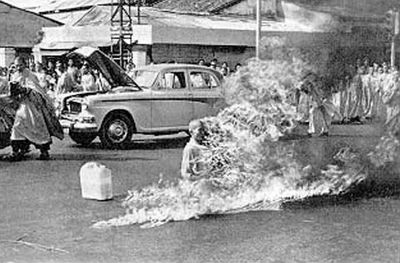
June 11, 1963
David Halberstam, a reporter for the New York Times covering the war in Vietnam, gave the following account: I was to see that sight again, but once was enough. Flames were coming from a human being; his body was slowly withering and shriveling up, his head blackening and charring. In the air was the smell of burning human flesh; human beings burn surprisingly quickly. Behind me I could hear the sobbing of the Vietnamese who were now gathering. I was too shocked to cry, too confused to take notes or ask questions, too bewildered to even think…. As he burned he never moved a muscle, never uttered a sound, his outward composure in sharp contrast to the wailing people around him.
Thich Quang Duc had prepared himself for his self-immolation through several weeks of meditation and had explained his motivation in letters to members of his Buddhist community as well as to the government of South Vietnam in the weeks prior to his self-immolation. In these letters he described his desire to bring attention to the repressive policies of the Catholic Diem regime that controlled the South Vietnamese government at the time. Prior to the self-immolation, the South Vietnamese Buddhists had made the following requests to the Diem regime, asking it to: Lift its ban on flying the traditional Buddhist flag; Grant Buddhism the same rights as Catholicism; Stop detaining Buddhists; Give Buddhist monks and nuns the right to practice and spread their religion; and Pay fair compensations to the victim's families and punish those responsible for their deaths.
When these requests were not addressed by the Deim regime, Thich Quang Duc carried out his self-immolation. Following his death, Thich Quang Duc was cremated and legend has it that his heart would not burn. As a result, his heart is considered Holy and is in the custody of the Reserve Bank of Vietnam.
